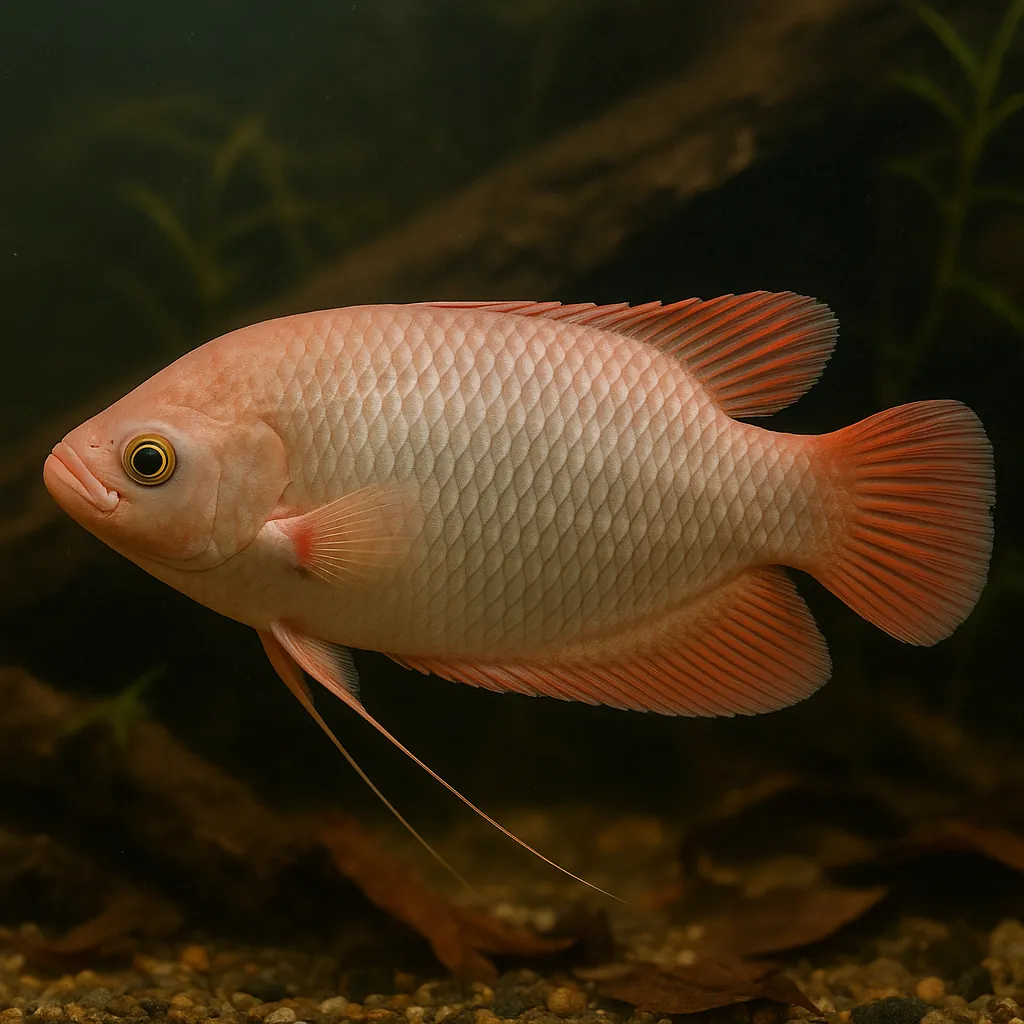
Giant red fin gourami
Introduction
The Giant Red Fin Gourami (Osphronemus laticlavius) is a striking freshwater fish renowned for its impressive size and vibrant red-edged fins. Native to Southeast Asia, this species has become a prized addition to large home aquariums due to its unique appearance and engaging behavior. While their captivating presence is appealing, they require substantial care and space, making them more suitable for experienced aquarists prepared to meet their specific needs.
Care and Environment
Caring for a Giant Red Fin Gourami involves providing a spacious and well-maintained environment that accommodates their substantial size and active nature.
What is the minimum tank size required for a Giant Red Fin Gourami?
A single adult requires a minimum tank size of 454 liters (120 gallons), but larger setups are recommended to ensure optimal health and comfort.
What are the ideal water parameters for this species?
Maintain a temperature between 22-28°C (72-82°F), pH levels from 6.2 to 7.2, and water hardness between 6-20°N (107.14 - 357.14 ppm).
How should the tank be decorated to suit a Giant Red Fin Gourami?
Use a fine-grained substrate like sand or smooth gravel, and incorporate sturdy plants, driftwood, and rocks to provide hiding spots and mimic their natural habitat.
A robust filtration system is essential to handle the significant waste produced by these large fish. Regular water changes of at least 10% weekly are recommended to maintain water quality.
Giant Red Fin Gouramis are omnivorous with a preference for plant-based foods. Their diet should include high-quality vegetable-based pellets, supplemented with fresh vegetables like lettuce, spinach, and peas. Occasional protein sources such as live or frozen foods can be offered, but the emphasis should remain on plant matter to prevent digestive issues.
These fish possess a labyrinth organ, allowing them to breathe atmospheric air. Therefore, ensure the tank has a secure lid to prevent jumping and provide access to the water surface for breathing.
Origin and Habitat
The Giant Red Fin Gourami is native to the slow-moving freshwater rivers and lakes of Malaysia and Indonesia. These environments are typically warm, with soft to moderately hard water, and are often densely vegetated. The fish thrive in areas with ample hiding spots among submerged roots and plants, which provide both shelter and foraging opportunities.
Temperament and Compatibility
Generally peaceful, Giant Red Fin Gouramis can become territorial, especially in confined spaces or during breeding periods. They are best housed with similarly sized, robust fish that can tolerate their size and occasional aggression.
What types of tank mates are suitable for a Giant Red Fin Gourami?
Suitable tank mates include large, peaceful species such as Oscar Cichlids, Silver Dollars, Clown Loaches, and Tinfoil Barbs.
Can Giant Red Fin Gouramis be kept with smaller fish?
It's advisable to avoid housing them with smaller fish, as they may be perceived as prey, leading to potential aggression.
How can aggression be minimized in a community tank?
Providing ample space and creating distinct territories within the tank can help reduce aggression among tank mates.
Interesting Facts
The Giant Red Fin Gourami is one of the largest gourami species, capable of reaching up to 50 cm (19.69 inches) in length. They possess a labyrinth organ, allowing them to breathe atmospheric air, an adaptation that enables survival in oxygen-poor waters. In the wild, males construct large bubble nests using vegetation, anchoring them to submerged structures during the breeding season. With proper care, these fish can live up to 40 years, making them a long-term commitment for aquarists.
Sources
All information in this article has been gathered from the following reputable sources:
Overview
Recommended Tank Size 264.2 Gallons (for optimal conditions and group housing) |
Minimum Group Size 1 |
Minimum Tank Volume 119.9 Gallons |
Maximum Adult Length 19.7 inches |
Average Adult Length 17.7 inches |
Shoaling (6+ required) No |
Preferred Water Type Freshwater, soft to moderately hard, neutral to slightly acidic |
Temperature Range (°C) 22-28 |
pH Range 6.2-7.2 |
Water Hardness (dGH) 6-20 |
Typical Lifespan (years) 40 years |